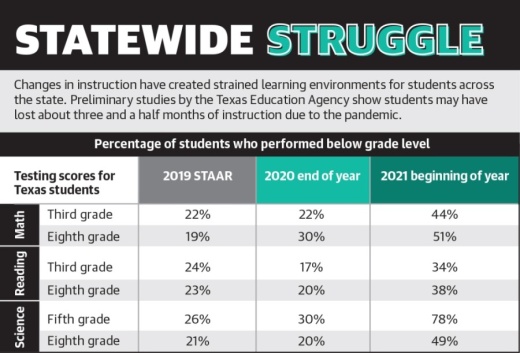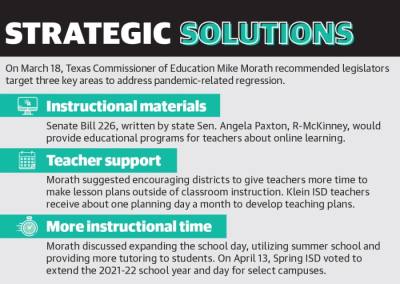Spring- and Klein-area school districts have begun planning for the 2021-22 school year, and educators said they are focusing on addressing students’ loss of learning due to the coronavirus pandemic.
Klein, Spring and Cy-Fair ISDs are all tackling what they call the “COVID-19 slide,” the loss of student achievement specific to the pandemic, among their student populations. Data from the districts shows in some subjects, more than 10% of students regressed between the 2019-20 and 2020-21 school years.
"This school year has been filled with many challenges, and like every school district, these challenges have impacted student achievement,” KISD Chief Academic Officer Amy Miller said in an email. “Our educators are working hard to close achievement gaps of any student who is struggling or seeing a decline in their performance.”
But district officials said this is not just a local issue. Texas students have lost more than three months of instructional time due to pandemic-related closures—not including the typical 2.5 months of summer learning loss, according to a January report by the Texas Education Agency.
After passing the Coronavirus Aid, Relief and Economic Security Act in March 2020, Congress passed more COVID-19 relief in December, giving Texas about $17.9 billion for education. As teachers and staff attempt to address students falling behind academically, statewide activists hope the federal assistance will allow for more targeted support for students.
“We’re hoping that [federal funding will] go towards ... tutoring programs and additional school days and high school credit recoveries and professional development and before- and after-school care,” said Bob Popinski, director of policy at education advocacy nonprofit Raise Your Hand Texas.
Sliding scores
Spring- and Klein-area school districts have tried to measure the extent of the learning loss through assessments. At a Feb. 4 board meeting, SISD officials said student achievement in reading fell slightly from 2019-20 to 2020-21, but the gaps in math were more significant with 55% of fourth-grade students at or above grade level in 2021 versus 64% in 2020.
In an emailed statement, SISD Communications Officer Sylvia Wood said remote learning limitations during the pandemic have exacerbated teachers’ already difficult task of addressing learning loss. However, in some subjects, remote students have performed better than their in-person peers, data shows. CFISD found similar achievement drops with the percentage of students reading at grade level dropping from 77% to 61% from January 2020 to January 2021. The district also found Black, Hispanic and economically disadvantaged student populations appear to be struggling the most, according to district data presented during a Feb. 10 board meeting. CFISD Chief Academic Officer Linda Macias said these three subgroups have historically performed below their white and more affluent peers.
“I heard a presenter that called it not so much [learning] gaps as much as unfinished learning—they have not had the opportunity to have all the instruction, the learning that needs to be occurring,” she said. Comparatively, KISD data actually showed more students met or exceeded projected growth during the pandemic. Data shows 47% of elementary students did not meet or exceed at least a year of projected growth in reading in their middle-of-year assessment in 2019-20 versus 40% for the same time in 2020-21.
KISD tracks student achievement by measuring students against their own performance in the previous year, with the goal of students achieving one year of growth each year, said Amanda Salinas, director of research and program evaluation for KISD. Although some students may not have met their projected growth, Salinas said it does not mean students performed below grade level, as many students are already performing above grade level.
Stacy Kindsfather, director of assessment and accountability at KISD, said she believes more students met or exceeded their projected growth because the district made a concentrated effort to ensure students were progressing despite the pandemic.
"Because we were aware of COVID[-19] and so much missed instruction, [we were] just being really targeted on really using data from [the beginning of the year] to make sure that we were targeting those students' areas where they needed instructional help," she said.
However, Greg Nelson, a senior economics teacher at Klein Cain High School, said he has seen student engagement—especially those doing remote learning—drop significantly this last year. Nelson said he attributes the disengagement to students struggling with mental health amid the pandemic, which is leading to declining grades.
“From an educator’s perspective, I would say the number one factor is mental health,” he said. “I look at my kids, even the ones that are sitting here in class, and they’re not engaged.” State efforts
The Texas Senate Committee on Education met March 18 with Texas Commissioner of Education Mike Morath during the 87th Texas Legislature. In his presentation, Morath said even with standardized state and local assessments in the pandemic, it is unclear how severe student regression is but that almost half of Texas students could be failing by the end of 2021.
Although some remote students fared worse than their in-person peers, Morath said remote learning has helped other students, namely older high school students.
“The short version is it’s bad,” Morath said. “It’s historically bad in terms of where our kids are and what we are going to need to do to support them.”
However, Rob D’Amico, the communications director for Texas American Federation of Teachers, a statewide union for educators and school employees, said the pandemic created chaos, but many teachers said they believe the effects will not be lifelong.
“It’s much more important to keep our communities, our parents, our students, our school employees safe ... than it is to become obsessed with potential learning loss,” D’Amico said.
To help better understand student progress amid the pandemic, the TEA brought back the State of Texas Assessments of Academic Readiness for the 2020-21 school year; the exam was not required last year. Although the TEA stated in its January report the scores will not be used for state or federal accountability purposes, some educators and advocacy groups are opposed to requiring the STAAR at all this year.
Texas AFT President Zeph Capo criticized spending time and money on “stressful, unnecessary standardized tests” during a pandemic.
“Our leaders should be ... making sure we have adequate time to let kids work on curriculum,” he said. “Endless test prep for STAAR also isn’t going to help our students, and the end result is going to be wasted time and money for bad data.”
Slow climb
Outside of STAAR, Miller said KISD teachers regularly assess student progress in formal and informal ways—from TEA-mandated assessments to goal-setting with individual students. She said teachers will address regression through small-group instruction, individualized learning in class and additional tutoring opportunities.
Meanwhile, Wood said SISD is increasing the frequency of its own assessments for the spring semester to every three weeks—as opposed to three times a year in the fall, winter and spring—to ensure learning gaps are promptly addressed. When gaps are found, Wood said the district creates instructional plans similar to KISD, which includes small-group instruction, additional tutoring and video lessons on specific topics students may be struggling with.
“We’re also going to be giving our parents of students in kindergarten through eighth grade a detailed snapshot of how their student is doing on the various assessments this year,” Wood said. “We know our parents can provide much support when we partner to address learning gaps.”
CFISD has also made efforts to curb the learning loss, from teachers giving more leeway and support for individual students to summer school availability for any student needing extra support and in-person and virtual tutoring opportunities, according to Macias.
However, officials at all three school districts said they were looking for state guidance on further ways to address the COVID-19 slide. In March, Morath recommended legislators focus on providing instructional materials, support for teachers and more instructional time to address pandemic-related regression.
Additionally, at an April 14 presentation, Morath said the $17.9 billion in federal funding will be allocated to school districts, but he said the Legislature is awaiting federal guidance before distributing it. He did not clarify how much or when districts would receive the funds.
“The legislative leadership is actually very interested in making sure that all districts are made whole in their COVID[-19] expenses,” he said.
Danica Lloyd and Kelly Schafler contributed to this report.







